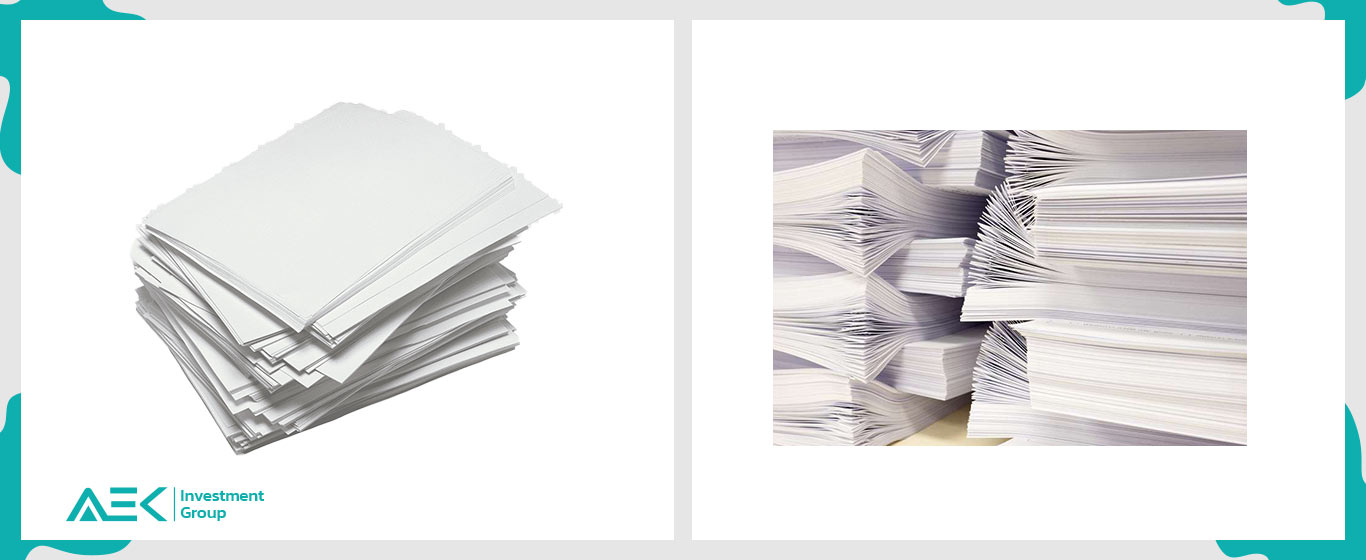
Writing papers
April 30, 2022
History of Paper
October 22, 2022
Corrugated fiberboard
Corrugated fiberboard is a material consisting of a fluted corrugated sheet and one or two flat linerboards. It is made on “flute lamination machines” or “corrugators” and is used for making cardboard boxes. The corrugated medium sheet and the linerboard(s) are made of kraft containerboard, a paperboard material usually over 0.01 inches (0.25 mm) thick. Corrugated fiberboard is sometimes called ‘corrugated cardboard’, although cardboard might be any heavy paper-pulp based board.
History
Corrugated (also called pleated) paper was patented in England in 1856, and used as a liner for tall hats, but corrugated boxboard was not patented and used as a shipping material until 20 December 1871. The patent was issued to Albert Jones of New York City for single-sided (single-face) corrugated board. Jones used the corrugated board for wrapping bottles and glass lantern chimneys. The first machine for producing large quantities of corrugated board was built in 1874 by G. Smyth, and in the same year Oliver Long improved upon Jones’ design by inventing corrugated board with liner sheets on both sides, thereby inventing corrugated board as it came to be known in modern times.
Scottish-born Robert Gair invented the pre-cut paperboard box in 1890 – flat pieces manufactured in bulk that folded into boxes. Gair’s invention resulted from an accident. He was a Brooklyn printer and paper-bag maker during the 1870s. While he was printing seed bags, a metal ruler used to crease bags shifted in position and cut them. Gair discovered that by cutting and creasing in one operation he could make prefabricated paperboard boxes. Applying this idea to corrugated boxboard was a straightforward development when the material became available in the early 20th century.
The corrugated box was first used for packaging glass and pottery containers. In the mid-1950s, the case enabled fruit and produce to be shipped from farm to retailer without bruising, improving the return to producers and opening export markets.
Properties
Several properties and characteristics can be measured for corrugated board. Some of these include:
- Moisture content ranges from 6.5-9.5%. If moisture is below a certain limit it will cause cracking in corrugated board and if it is above then it will reduce the compression strength of board.
- Edge crush test measures force per unit width and predicts Box compression strength. It is reported in KN/m or lb/inch.
- Burst strength is the pressure required to rupture corrugated sheet. It is reported in KPa or lb/inch2.
- Box Compression strength is the direct measurement of performance of corrugated boxes. It is reported in kgf or N.
- Flat crush test measures flutes rigidity and reported in KPa.
- Bending resistance
- Impact resistance
- Cushioning, shock absorption
- Tear resistance
- Grammage is the weight per meter square of any material. It is reported in g/m2
Corrugated fiberboard is anisotropic; many of its properties are highly directional. For example, edge crush, bending stiffness, tensile, and surface characteristics are different, depending on the orientation to the flutes and the machine direction of manufacture.
Manufacturing
Corrugated board is manufactured on large high-precision machinery lines called corrugators, usually running at about 500 feet per minute (150 m/min) or more. These machines, over time, have become very complex with the objective of avoiding some common problems in corrugated board production, such as warp and washboarding.
The key raw material in corrugating is paper, different grades for each layer making up the corrugated box. Due to supply chain and scale considerations, paper is produced in separate plants called paper mills. Most corrugating plants keep an inventory of paper reels.
In the classical corrugator, the paper is softened with high-pressure steam. After the board is formed it is dried in the so-called dry-end. Here the newly formed corrugated board is heated from the bottom by hot plates. On the top, various pressures are applied by a load system on the belt.
The corrugated medium is often 0.026 pounds per square foot (130 grams per square metre) basis weight in the US; in the UK, a 90 grams per square metre (0.018 lb/sq ft) fluting paper is common. At the single-facer, it is heated, moistened, and formed into a fluted pattern on geared wheels. This is joined to a flat linerboard with a starch based adhesive to form single face board. At the double-backer, a second flat linerboard is adhered to the other side of the fluted medium to form single wall corrugated board. Linerboards are test liners (recycled paper) or kraft paperboard (of various grades). The liner may be bleached white, mottled white, colored, or preprinted.
Common flute sizes are “A”, “B”, “C”, “E” and “F” or microflute. The letter designation relates to the order that the flutes were invented, not the relative sizes. Flute size refers to the number of flutes per linear foot, although the actual flute dimensions for different corrugator manufacturers may vary slightly. Measuring the number of flutes per linear foot is a more reliable method of identifying flute size than measuring board thickness, which can vary due to manufacturing conditions. The most common flute size in corrugated boxes is “C” flute.
| Flute designation | Flutes per foot | Flute thickness (in) | Flutes per meter | Flute thickness (mm) |
|---|---|---|---|---|
| A flute | 33 ± 3 | 3⁄16 | 108 ± 10 | 4.8 |
| B flute | 47 ± 3 | 1⁄8 | 154 ± 10 | 3.2 |
| C flute | 39 ± 3 | 5⁄32 | 128 ± 10 | 4.0 |
| E flute | 90 ± 4 | 1⁄16 | 295 ± 13 | 1.6 |
| F flute | 125 ± 4 | 1⁄32 | 420 ± 13 | 0.8 |
Reference: Wikipedia




